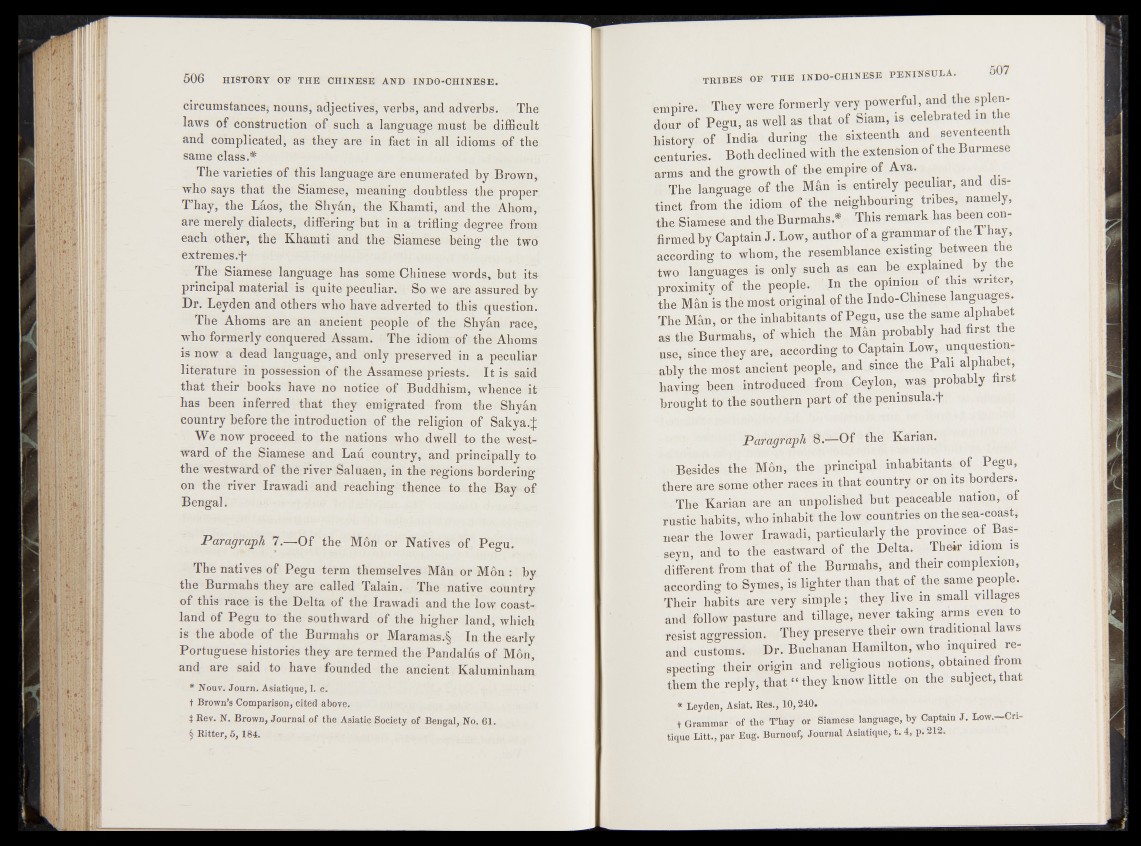
circumstances? nouns,: adjectives, verbs, and adverbs. The
laws of construction of; such a language must be difficult
and complicated? as they are in-fact in all idioms ,of the
same class.*
The varieties of this' language are enumerated by Brown,
who says that the Siamese, m eaning.• doubtless^h# pjqfier
T’hay, the Laos, the Shy&n, the Khamti, and.the Ahorn,-
are merely dialects, differing but in a trifling degree from
each other, the Khamti and the Siamese being the two
extremes.^
I The Siamese language has some Ghinese words, hut its*
principal material is quite peculiar. • So we are assured by
Dr. Leyden and others who have adverted to this question.
The Ahorns are an ancient people?^of-the ^»amirace,
who formerly conquered Assam. Thé idiomrof^theiAhomS
is now a dead language, andbnly preserved in a peculiar
literatuirem possession of the Assamesefpriests§ It is said
that their books have no notice .of Buddhism», whence it
has been inferred that they emigrated from thé+lShydn
country before the introduction of the religion *èf Saky^J
We now proceed to the nations who dwell to the westward
of the Siamese and Lau country* and prindpally tq
the westward of the river Saluaen, in the regions bordering
on the river Ira wadi and reaching' thence to aÉè.Bay^of
Bengal.
Paragraph 7.—Of the Mon' or Natives of Pegu.
The natives of Pegu term themselves M&n or M6n: by
the Burmahs they are called Talain. The native country
of this race is the Delta of the Irawadi and the low coast-
land of Pegu to the southward of the higher land, which
is »the abode of the Burmahs or Maramas.§ In the yearly
Portuguese hisiories they are termed the Pandalhs of M6n,
and are said to have founded the ancient Kaluminham
* Nouv; Journ. Asiatiqne, I.':M
t Brown's Comparison, cited above.
t Rev. N. Brown, Journal of the Asiatic Society of Bengal, No. 01,
$ Ritter, 5,184.
empire. They were formerlywery powerful, and the splendour
-of Pegu, as well as that of .Siam, is celebrated m the
history>fof:■ India during th e . sixteenth and seventeenth
centuries^ Both dec’lihedwith thé extension of the Burmese
arms and the growth of tlm empire; of Ava. -
I The language of the Mhn .is entirely peculiar, and distinct
from thelidiom of the neighbouring tribes, namely,
the Siamese and the Burmahs * This remark h a s , ^ c o n firmed
by Captain J. Low, author, of a grammar of the I bay,
according to whom, the resemblance existing between the
two languages-ist^iily Shch as can be explamed by the
proximity of the people. ' In the opinion of this writer,
I the Man is thé most ^original of;theT^do:Chmes^ languages.
The Man, or the inhabitants qf Pegu, use the same alphabet
as thé Burmahs, ofiwhfoh the Man probably had first the
~use, ,skiice:they are, acc.orJdmg to Captain Low, unquestion-
ably thetmost ancient people, and since.-the Pali alphabet
having been introduced, from Ceylon, was probably hrst
Paragraph Of the Karian.
Besides the Mo » the principal ^.inhabitants of Pegu,
there are some other, races in that country .or on its.borders.
The Karian are an unpolished but peaceable nation, of
rustic habits, who inhabit the low countries on the sea-coast,-
near the lower Irawadi, particularly the province of Bas-
seyn, and to the eastward of the Delta. Their idiom is
different from that of the Burmahs, and their complexion,
according to« Symes, ie lighter «than that of # e same people.
Their habits are very simple;? they live m small villages
and fo llo w pasture and tillage,.never taking arms even to
resist aggression. They preserve, their own traditional laws
and customs. Dr. Buchanan Hamilton, who inquired respecting
their origin and religious, notions, obtained from
them the reply, that “ they know little on the subject, that
* Leyden, Asiat. Res., 10,240.
_ t Grammar of the T’hay or Siamese language, by Captain J. Low.-Cn-
tique Litt., par Eug. Burnouf? Journal Asiatique,. t, 4, p. 212,